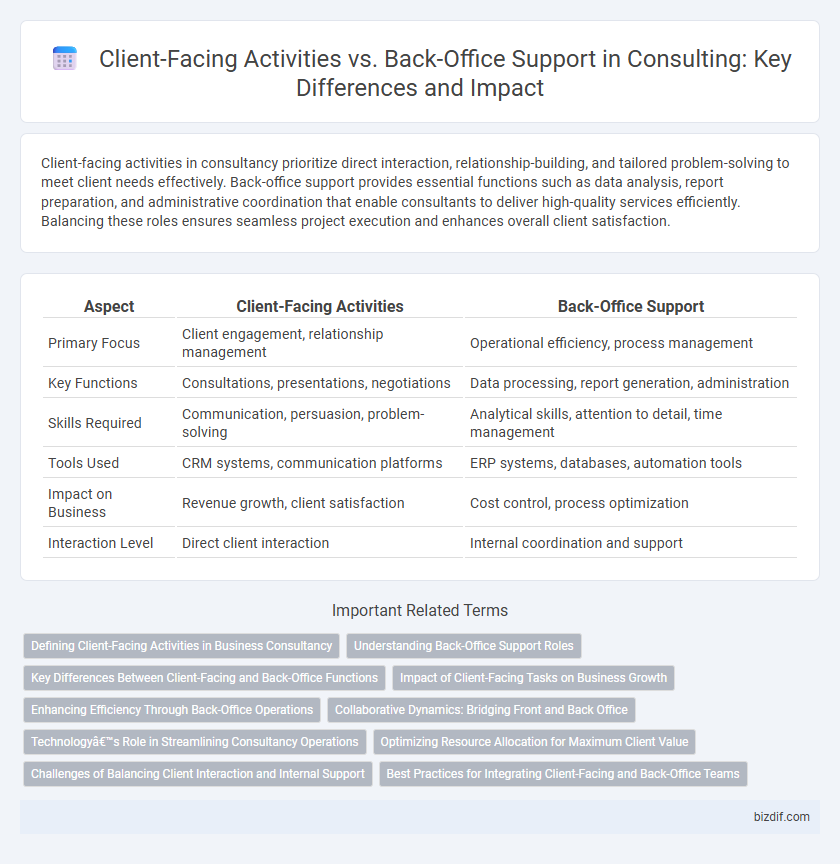Client-facing activities in consultancy prioritize direct interaction, relationship-building, and tailored problem-solving to meet client needs effectively. Back-office support provides essential functions such as data analysis, report preparation, and administrative coordination that enable consultants to deliver high-quality services efficiently. Balancing these roles ensures seamless project execution and enhances overall client satisfaction.
Table of Comparison
| Aspect | Client-Facing Activities | Back-Office Support |
|---|---|---|
| Primary Focus | Client engagement, relationship management | Operational efficiency, process management |
| Key Functions | Consultations, presentations, negotiations | Data processing, report generation, administration |
| Skills Required | Communication, persuasion, problem-solving | Analytical skills, attention to detail, time management |
| Tools Used | CRM systems, communication platforms | ERP systems, databases, automation tools |
| Impact on Business | Revenue growth, client satisfaction | Cost control, process optimization |
| Interaction Level | Direct client interaction | Internal coordination and support |
Defining Client-Facing Activities in Business Consultancy
Client-facing activities in business consultancy involve direct interaction with clients to understand their needs, provide tailored solutions, and manage ongoing relationships, ensuring alignment with business objectives. These activities include conducting workshops, delivering presentations, and offering strategic advice that drives client value and project success. Effective client-facing roles demand strong communication skills, industry knowledge, and the ability to translate complex insights into actionable recommendations.
Understanding Back-Office Support Roles
Back-office support roles in consultancy encompass essential functions such as data analysis, IT management, and financial accounting that ensure operational efficiency without direct client interaction. These roles optimize project delivery by managing internal workflows, maintaining compliance, and providing critical insights that enable client-facing teams to focus on strategic engagement. Effective back-office support underpins successful consultancy outcomes through seamless coordination and resource management behind the scenes.
Key Differences Between Client-Facing and Back-Office Functions
Client-facing activities primarily involve direct interaction with clients, including proposal development, presentations, and addressing client needs to build trust and ensure project alignment. Back-office support functions focus on internal processes such as data management, financial reporting, and administrative tasks that enable efficient operations without direct client engagement. The key differences lie in the focus on external relationship management versus internal operational support, with client-facing roles driving revenue generation and back-office roles ensuring organizational stability.
Impact of Client-Facing Tasks on Business Growth
Client-facing activities drive business growth by directly enhancing customer relationships, fostering trust, and identifying client needs for tailored solutions. These interactions generate immediate revenue opportunities and valuable feedback that informs strategic decisions and service improvements. Effective client engagement increases retention rates and referrals, creating a sustainable competitive advantage over competitors reliant solely on back-office support.
Enhancing Efficiency Through Back-Office Operations
Back-office support plays a critical role in enhancing consultancy efficiency by streamlining administrative tasks such as data management, compliance tracking, and financial reporting, allowing client-facing teams to focus on strategic advisory and relationship-building activities. Optimized back-office operations leverage automation and integrated software solutions to reduce errors and accelerate process workflows, thus improving overall project turnaround times. Investing in robust back-office infrastructure enables consultancies to deliver higher-quality client services, increase responsiveness, and maintain competitive advantage in dynamic markets.
Collaborative Dynamics: Bridging Front and Back Office
Collaborative dynamics between client-facing activities and back-office support are crucial for seamless consultancy operations, ensuring real-time information flow and consistent client engagement. Effective integration of CRM systems and transparent communication channels bridges gaps, enabling front-line consultants to access critical data from support teams swiftly. This synergy enhances decision-making, accelerates problem resolution, and fosters a unified approach to delivering client value.
Technology’s Role in Streamlining Consultancy Operations
Technology enhances client-facing activities by enabling real-time communication, personalized data analysis, and interactive dashboards that improve client engagement and decision-making. In back-office support, automation tools streamline administrative tasks, data management, and reporting, significantly reducing human error and operational costs. The integration of AI-driven systems across consultancy operations ensures seamless coordination between client services and support functions, boosting overall efficiency and scalability.
Optimizing Resource Allocation for Maximum Client Value
Client-facing activities directly engage clients through strategy development, presentations, and relationship management, driving revenue and satisfaction. Back-office support, including data analysis, report generation, and administrative tasks, ensures operational efficiency and accuracy. Optimizing resource allocation by balancing skilled client-facing consultants with specialized back-office teams maximizes client value and enhances overall consultancy performance.
Challenges of Balancing Client Interaction and Internal Support
Balancing client-facing activities with back-office support presents significant challenges in consultancy, as consultants must manage time efficiently between direct client engagement and critical internal tasks such as data analysis, reporting, and project coordination. High client demands often limit opportunities for consultants to update internal systems, leading to potential delays in deliverables and reduced operational efficiency. Effective resource allocation and streamlined communication protocols are essential to maintain service quality while ensuring timely internal support functions.
Best Practices for Integrating Client-Facing and Back-Office Teams
Successful integration of client-facing and back-office teams in consultancy relies on seamless communication protocols and shared access to real-time project management tools like Asana or Jira. Establishing cross-functional workflows and regular alignment meetings ensures that back-office support anticipates client needs while client-facing consultants provide timely feedback on operational challenges. Implementing centralized knowledge bases and CRM systems such as Salesforce enhances transparency, driving efficiency and client satisfaction across both teams.
Client-Facing Activities vs Back-Office Support Infographic

 bizdif.com
bizdif.com